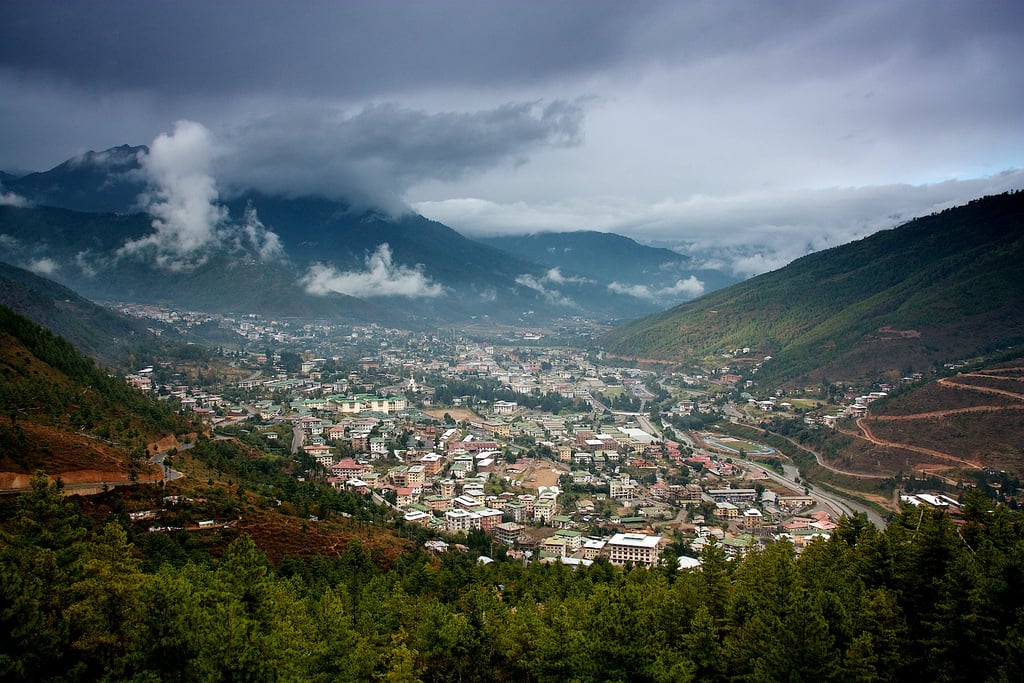Bhutan fires the imagination of an ideal mountain country with many snow-clad peaks, where people go about their daily chores in serenity, dressed in their national dress, wearing a smile and with a song on their lips. The image of the Gross National Happiness (GNH) that it portrays is ever present. The four pillars of the GNH are sustainable and equitable development, conservation of the environment, cultural preservation and good governance. It was with these expectations that I made my first visit to Bhutan recently, to find out more about Bhutan’s hydropower plans. I returned with some memorable experiences and apprehensions of Bhutan’s future – of its GNH.
The taxi driver smiled most of the drive from the airport in Paro to Thimphu, the capital. He stopped to refill his water bottle at a spring, to give a ride to a local schoolteacher, stopped to buy doma (betel nut leaf with lime and half an areca nut), and chatted with other drivers on the way. He was a picture of happiness, of a slow relaxed life. Even the policeman understood when he stopped the taxi in a no parking area to buy doma.
In contrast, bureaucrats, elected representatives, consultants to the Royal Government of Bhutan and NGOs were all extremely busy either travelling or in long meetings. But they did all make time to meet with me, at relatively short notice. They were clearly responsive and bureaucrats immediately responded to subsequent emails. This was refreshing when compared to Indian bureaucrats who seldom, if ever, respond.
All of the people I spoke to were clear that Bhutan’s economic growth depends on hydropower, that hydropower is here to stay. But none acknowledged the negative impacts of dams. Nor did they acknowledge that some factors, including climate change and GLOFs (Glacial Lake Outburst Floods), have not been considered while deciding to exploit the nation’s hydropower potential.
Lack of civil society opposition
In this, it is evident that Bhutan is a nascent democracy. People are neither accustomed to nor confident enough to oppose their government’s plans. At the moment, there is not a sufficient NGO voice responding to the government’s plans. There are only a few environmental NGOs in the country and the government supports all of them. If there were more independent environmental NGOs, perhaps louder voices would have been heard against the two Punatsangchhu hydropower projects. But this is likely to change. In 2007, Bhutan passed a law to permit the establishment and registration of civil society organisations.
The two Punatsangchhu projects will destroy the habitat of about 20 white bellied heron, which account for roughly 10% of the world’s population. They are a critically endangered species on the 2007 International Union for Conservation of Nature (IUCN) red list, with only about 200 of them in the world. There has been no loud local opposition to the project on this or any other grounds, nor have there been objections raised by IUCN or other global wildlife NGOs. Perhaps they were not aware.
However, it may not be too late yet. Only the coffer dam of Punatsanchhu-I and some tunnels of the 1,200 mega-watt Punatsanchhu-I and 990 mega-watt Punatsanchhu-II have been constructed. For example, an international discourse could still be initiated on how Bhutan can be compensated for protecting the habitat of a globally critically endangered species.
Everyone including bureaucrats, elected representatives and NGOs are aware that the projects will result in the destruction of the white bellied heron’s habitat. One elected representative said that Bhutan would not develop the dams if the country was given the money not to. However, he had no reply to the question of why some other dam site could not have been selected instead. Bhutan has committed to provide 10,000 megawatts of power to India by 2020 out of an estimated 30,000 megawatts of hydropower potential. Why can’t Bhutan assess which project will have the least impacts and develop those?
Poor environmental checks and balances
While Bhutan does have an Environment Impact Assessment (EIA) process, it still needs to evolve. The National Environment Commission screens projects and decides whether or not a project needs an EIA report and public hearings. The criteria for this decision are not clear. No one in civil society organisations has seen EIA reports of these two projects and queries to bureaucrats as to whether or not the EIAs exist remain unanswered. Public consultations and meetings under the EIA process are carried out by the project proponent, and are generally restricted to meetings with select individuals in the affected areas. The government holds no public consultations and meetings.
It is not clear how Bhutan can hope to avoid the usual environmental problems unless EIAs are made mandatory for all large-scale projects, including dams, shared with the public, public consultations and meetings held and interests of local people safeguarded. This needs to be done especially in light of the fact that access to information is a constitutional right in Bhutan. Perhaps Bhutan can refer to India’s EIA regulations (which, on paper, are good) and improve on its downsides and on its implementation in India.
Samir Mehta is South Asia programme director at International Rivers.
Photos courtesy of Ritwick Dutta.
An earlier version of this article was published by International Rivers
